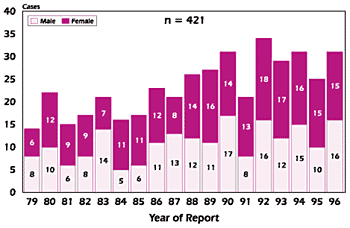Common menu bar links
Institutional links
Diseases & Conditions
Health & Safety
Research & Statistics
Agency Information
Search Box
E-mail this page
Creutzfeldt-Jakob Disease
Quick Links
CJD-Surveillance System
| Newsletters to Families | Newsletters to Physicians |
September 1999
PDF version ![]() (88 KB)
(88 KB)
[How to download PDF documents]
Surveillance for Creutzfeldt-Jakob Disease in Canada
In Canada, the epidemiologic pattern and rate of CJD remains steady and consistent with the epidemiology in the rest of the world(1,2).
Information on the epidemiology of CJD in Canada is derived from published Statistics Canada mortality data for the years 1979 to 1996 (CJD was not listed as a cause of death before 1979). Figure 1 shows reported CJD mortality by sex for Canada.
Eighty percent of deaths occurred in persons at least 60 years old, and 50% occurred in the 60-69 year-old age group, corresponding to the peak age of onset for sporadic-type CJD(2). Thirteen deaths (3%) were reported in persons 30-44 years of age, spanning the years 1979 to 1996. No CJD deaths were reported in persons < 30 years old. New variant CJD, which is associated with consumption of BSE-contaminated beef, has not been reported in Canada.
Figure 1. CJD in Canada 1979-96: Annual Mortality by Sex  |
Study Update
Health Canada conducts active surveillance for CJD through the CJD Surveillance System (CJD-SS). Information collected from the surveillance system will be used to determine whether there is any risk that CJD will develop as a result of a blood/blood product transfusion or a tissue transplantation. As a member of an international project team, CJD-SS Canada also conducts surveillance for new variant CJD (nv-CJD).
In April 1998, CJD-SS launched the first mailout for the system: 1,000 physicians in Canada, including neurologists, neuropathologists and geriatricians, received information packages on the study and were asked to notify CJD-SS of any cases of CJD seen since 1994. A second mailout to non-responders and to infectious disease practitioners was completed in September 1998. The response rate has been 50%, and 84 cases have been reported, originating in all regions of the country. Follow-up with notifying physicians is now under way to remove duplicate reports and initiate contact for study enrollment.
CJD-SS has three field investigators who have begun interviewing families and collecting data. To date, 54 patients have been enrolled in the study. Some of these have been determined not to have CJD.
CJD-SS will continue to use active surveillance methods to seek out and investigate all cases of CJD occurring in Canada. We expect to be notified of cases primarily through neurologists, neuropathologists and geriatricians. However, we ask any physician aware of a case of CJD to please contact the surveillance system using our toll free number - 1-888-489-2999 - and make a non-nominal report.
References
- Stratton EE, Ricketts MN, Gully PR. Creutzfeldt-Jakob disease in Canada. CCDR 1996;22:57-61.
- Will RG. Prion disease surveillance. In: Baker HF, Ridley RM, eds. Methods in molecular medicine: Prion diseases. Totowa NJ: Humana Press, 1996:128.
